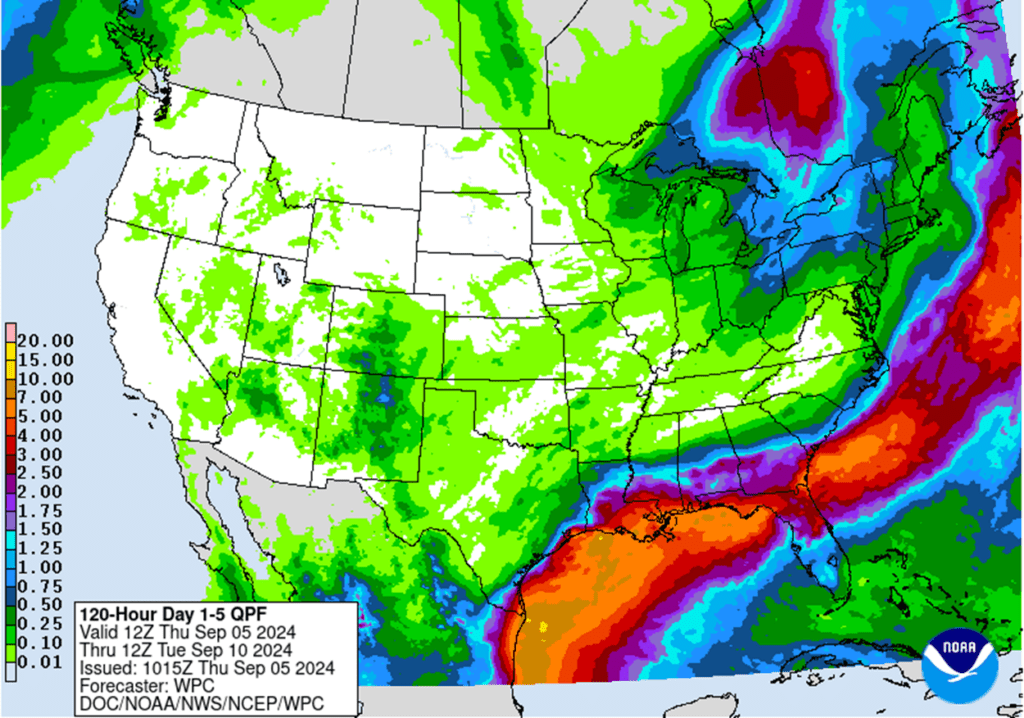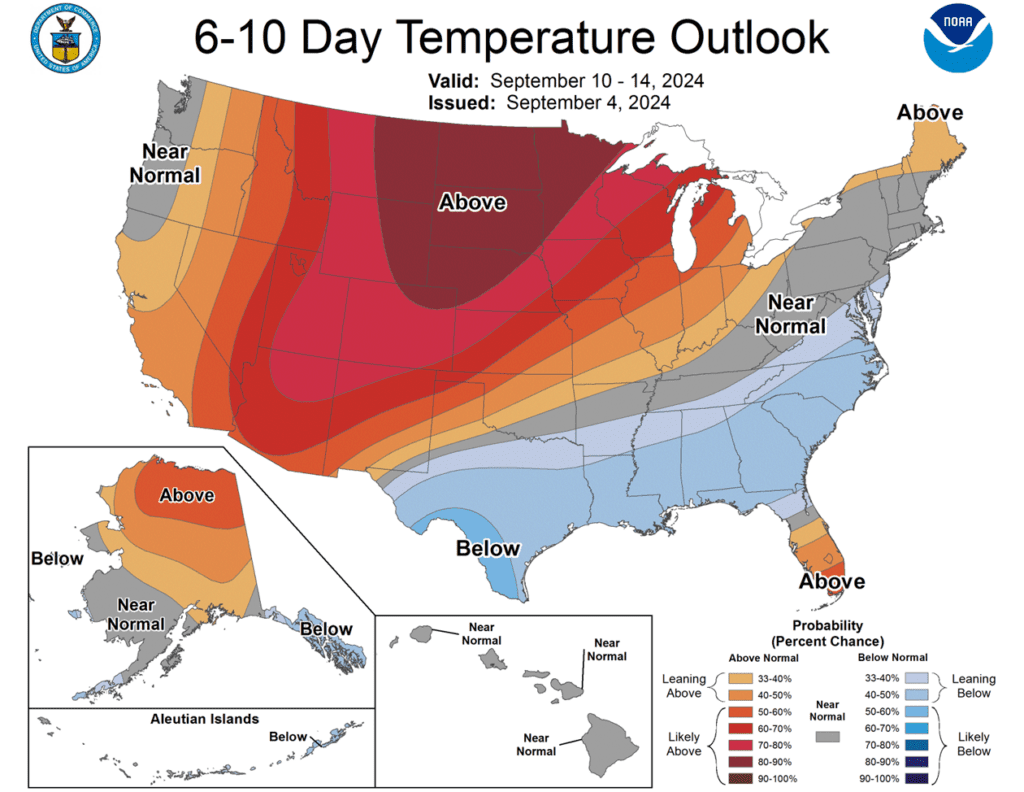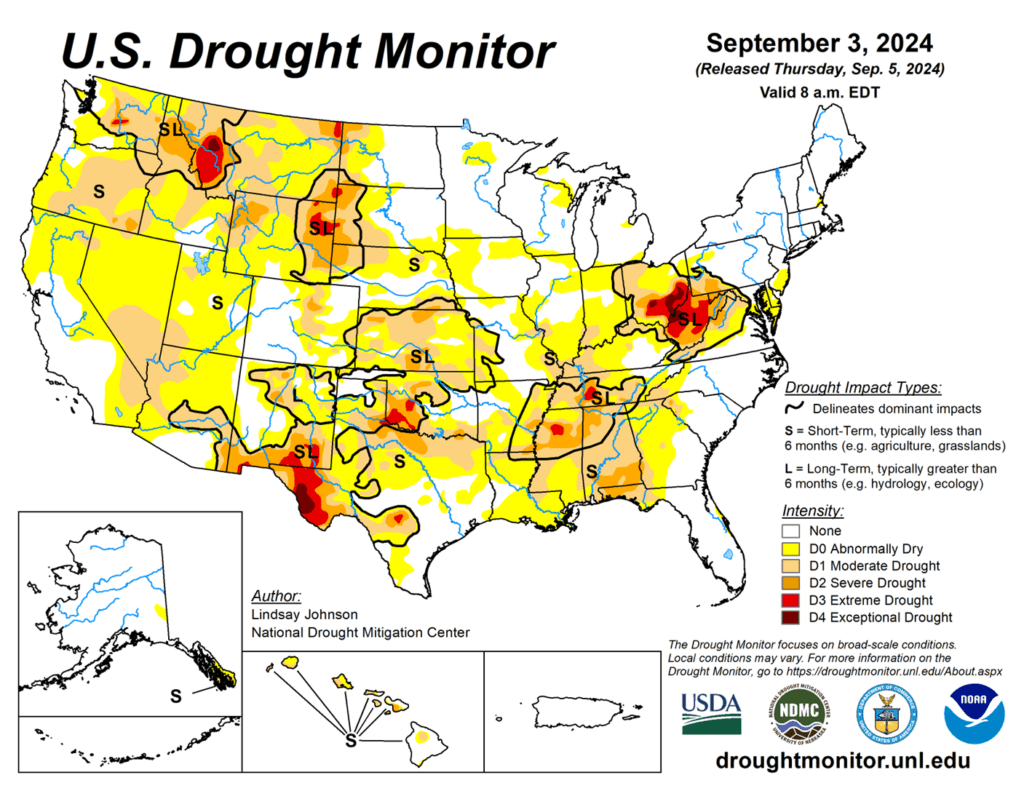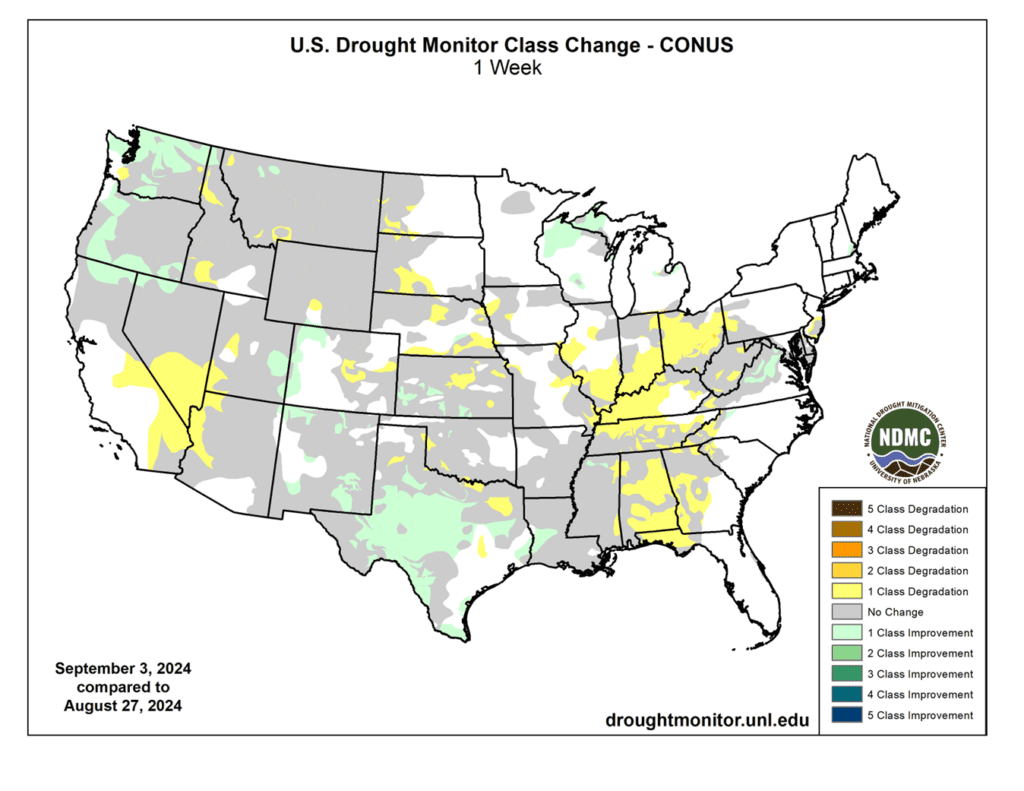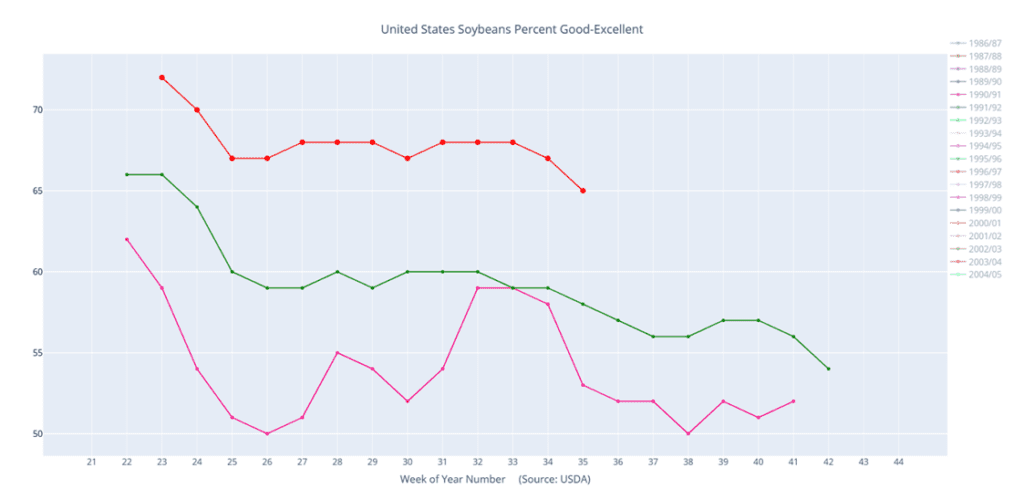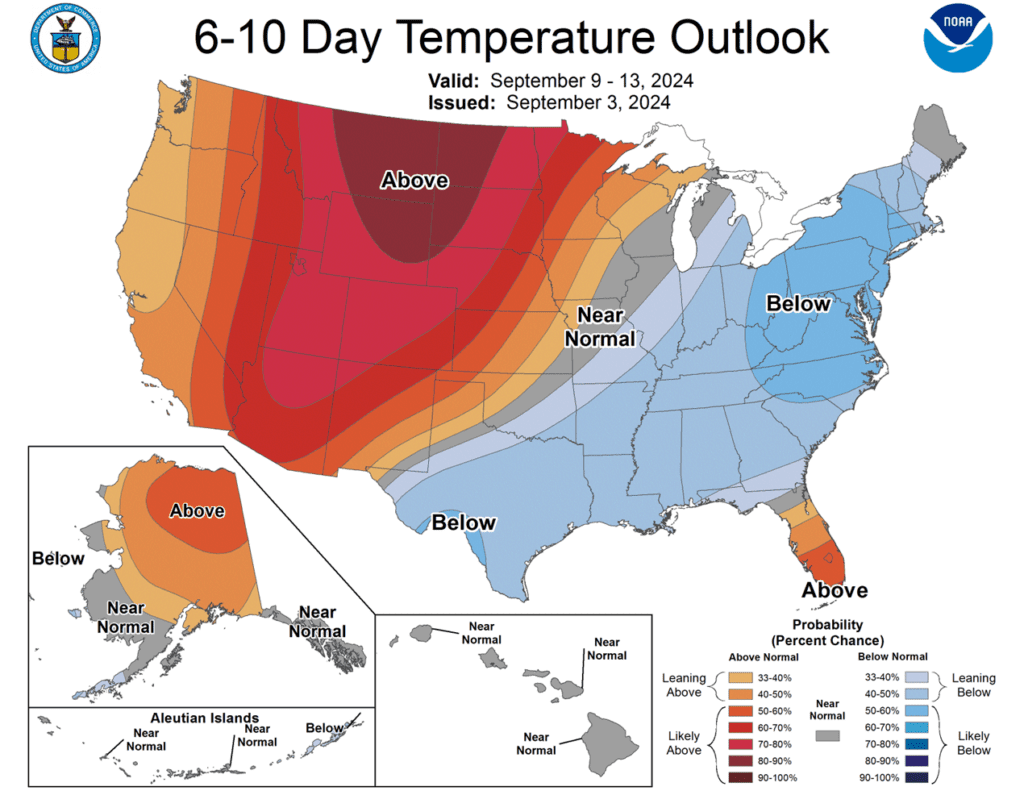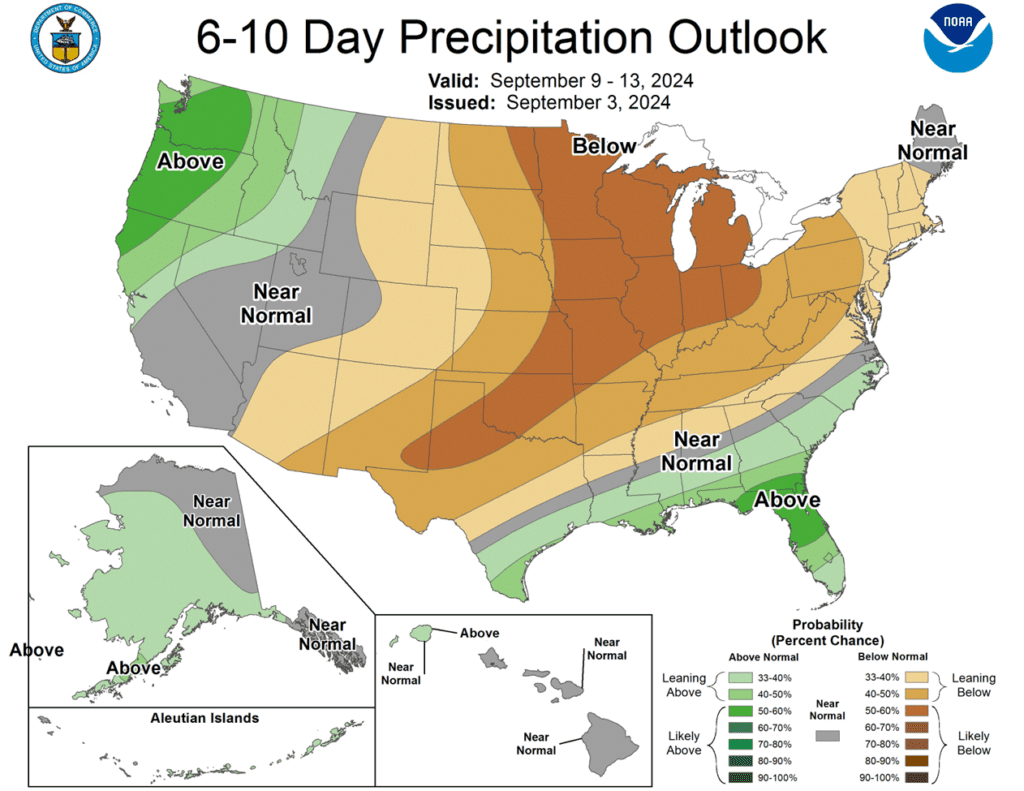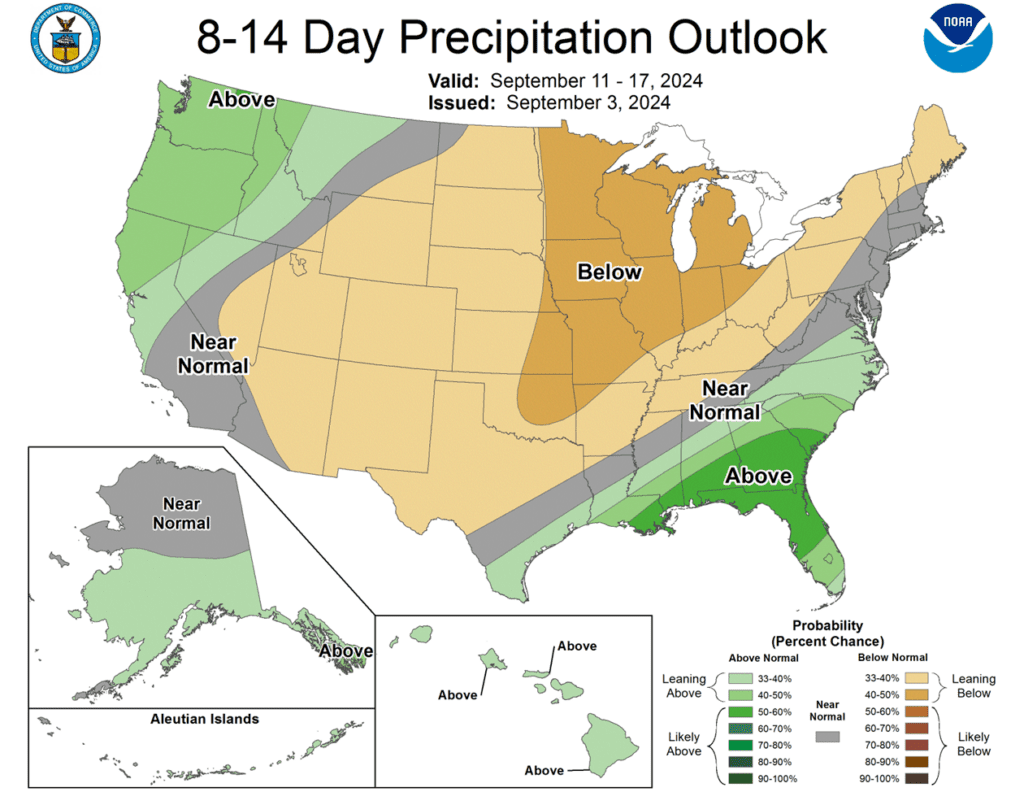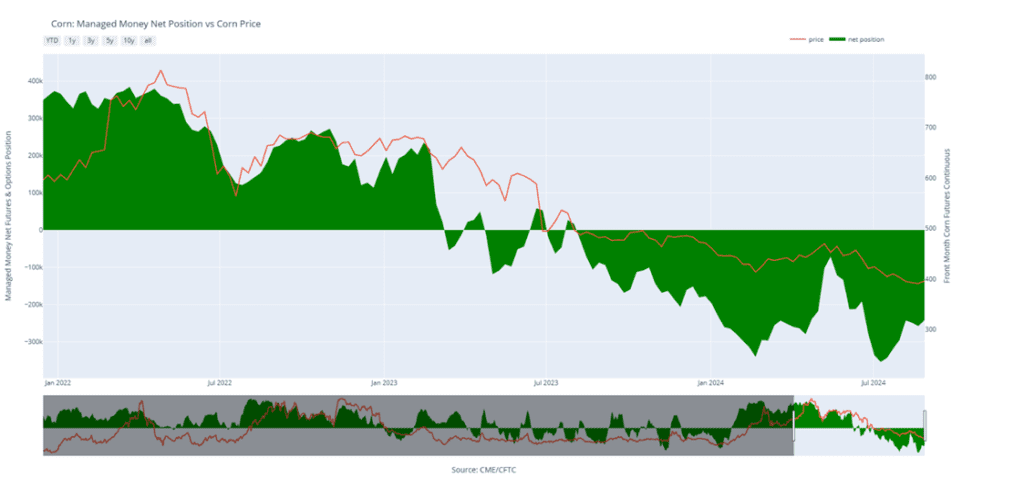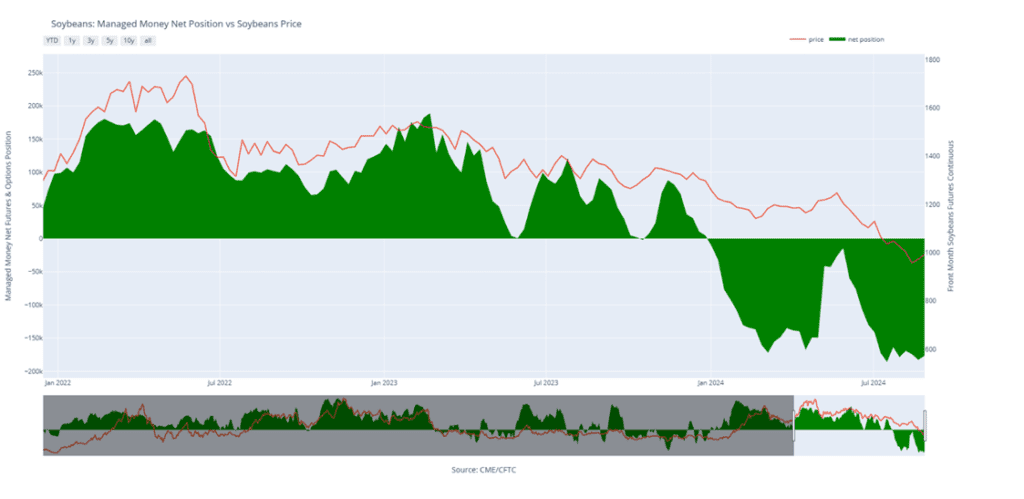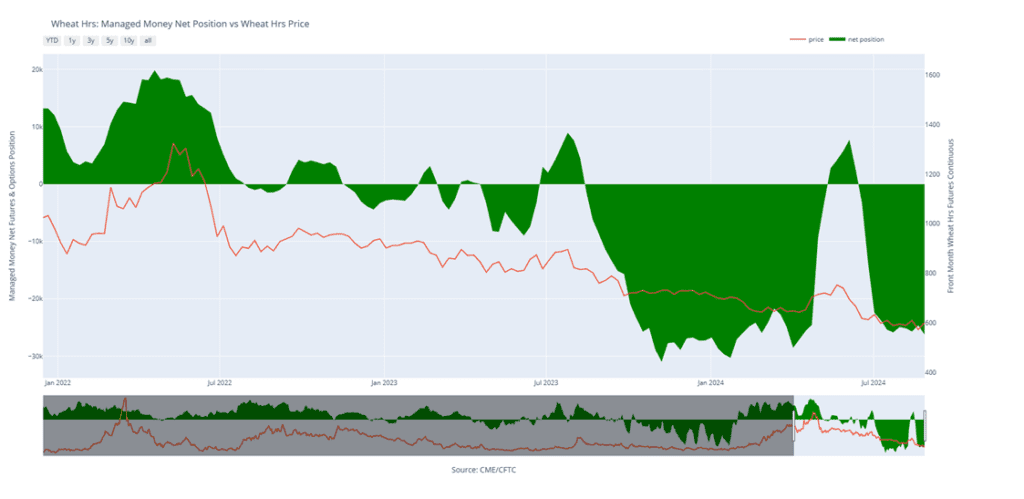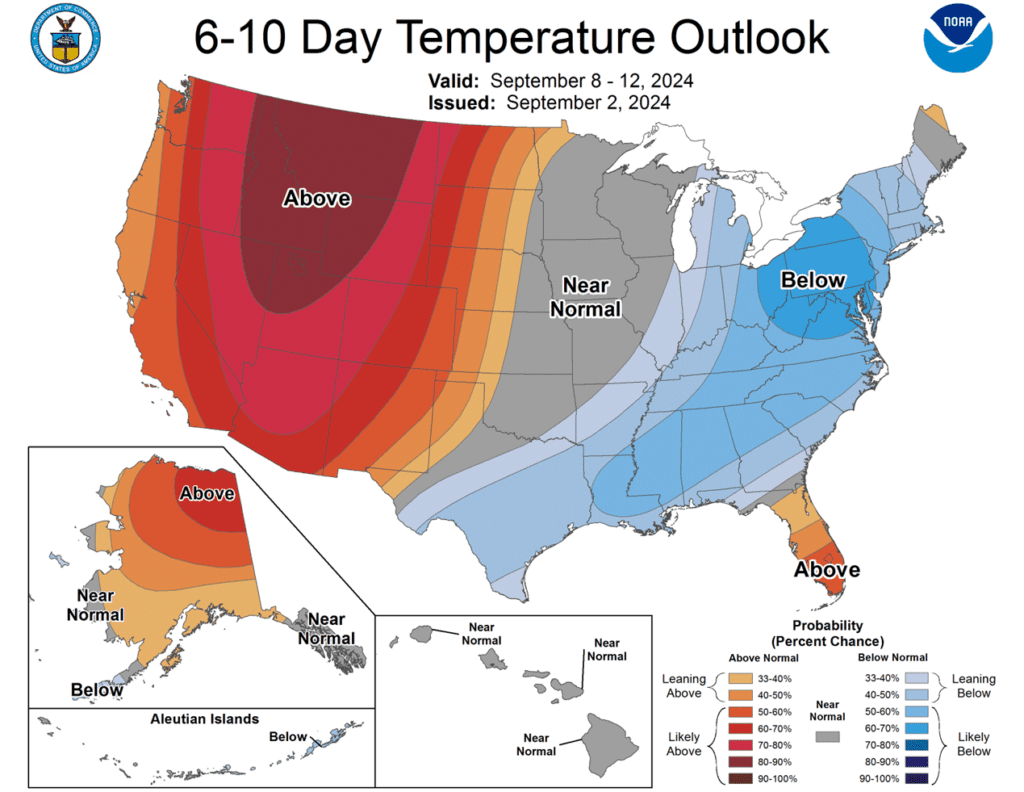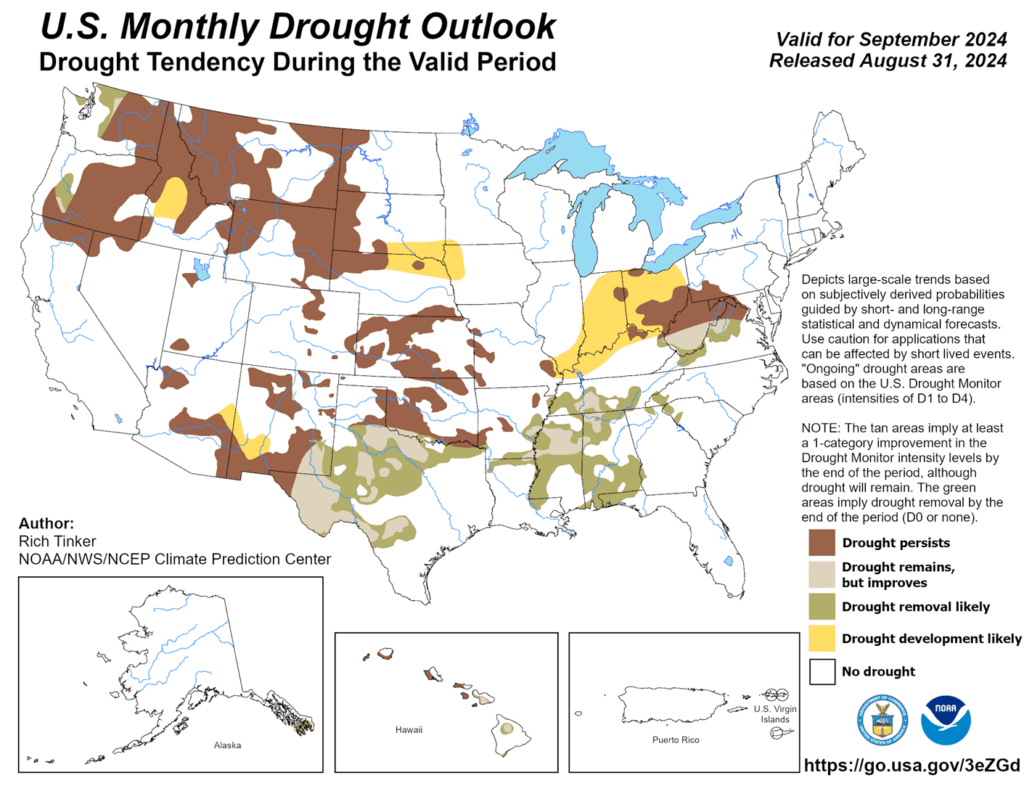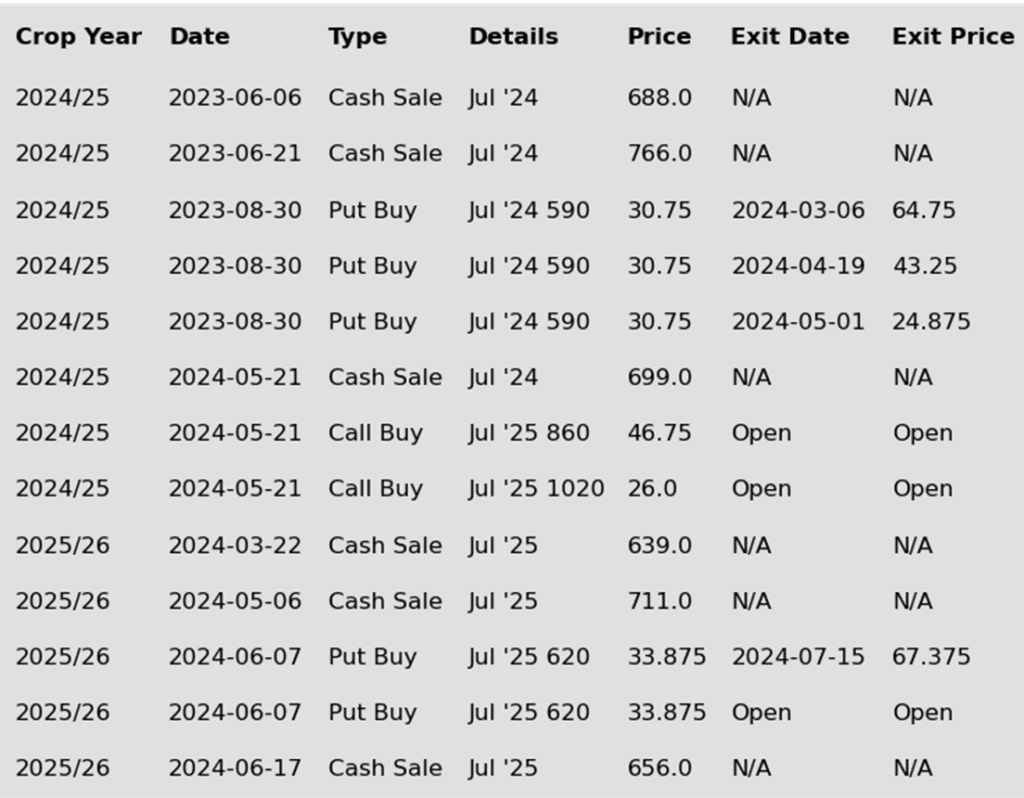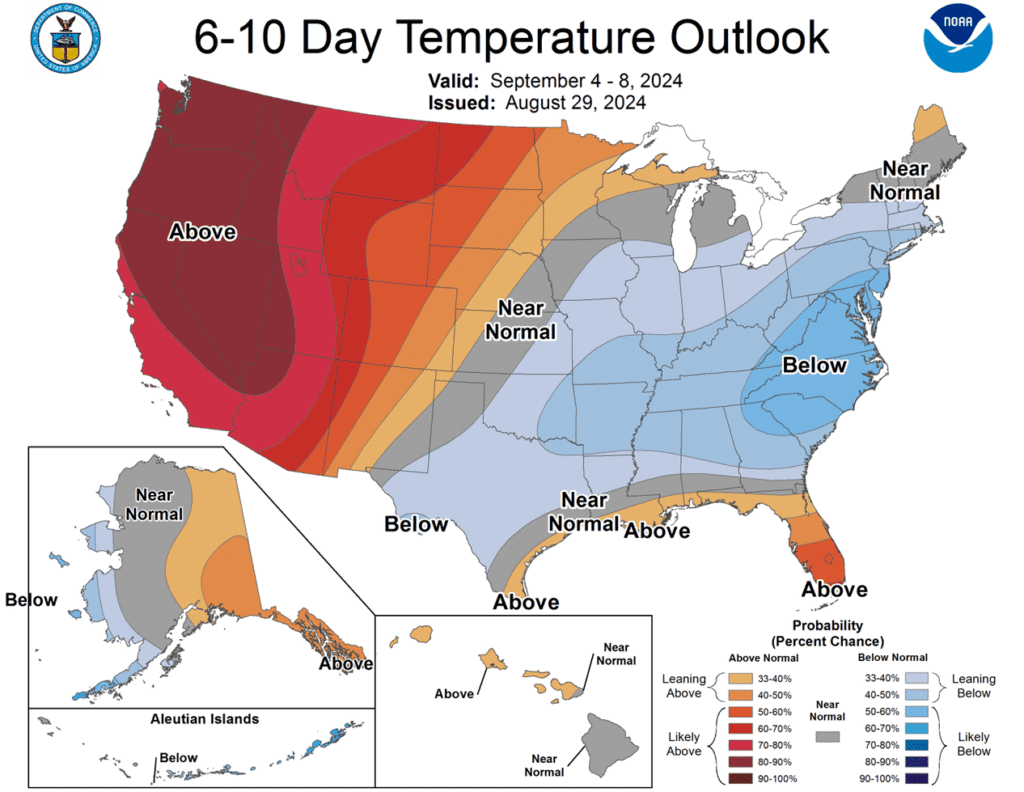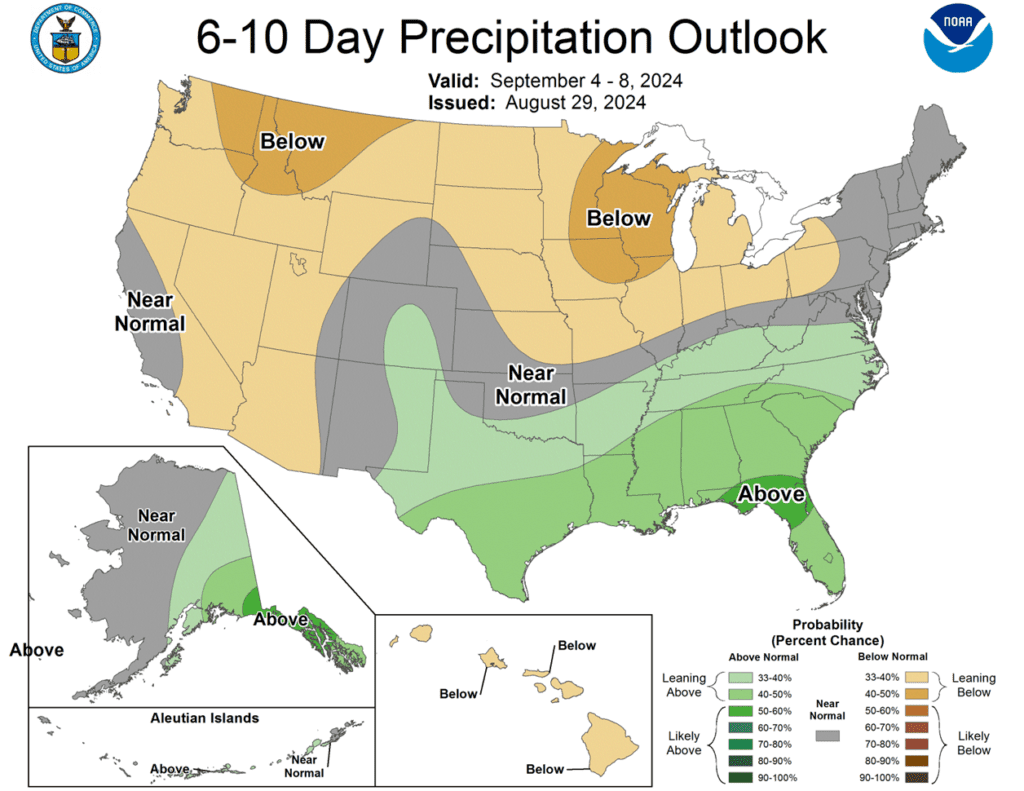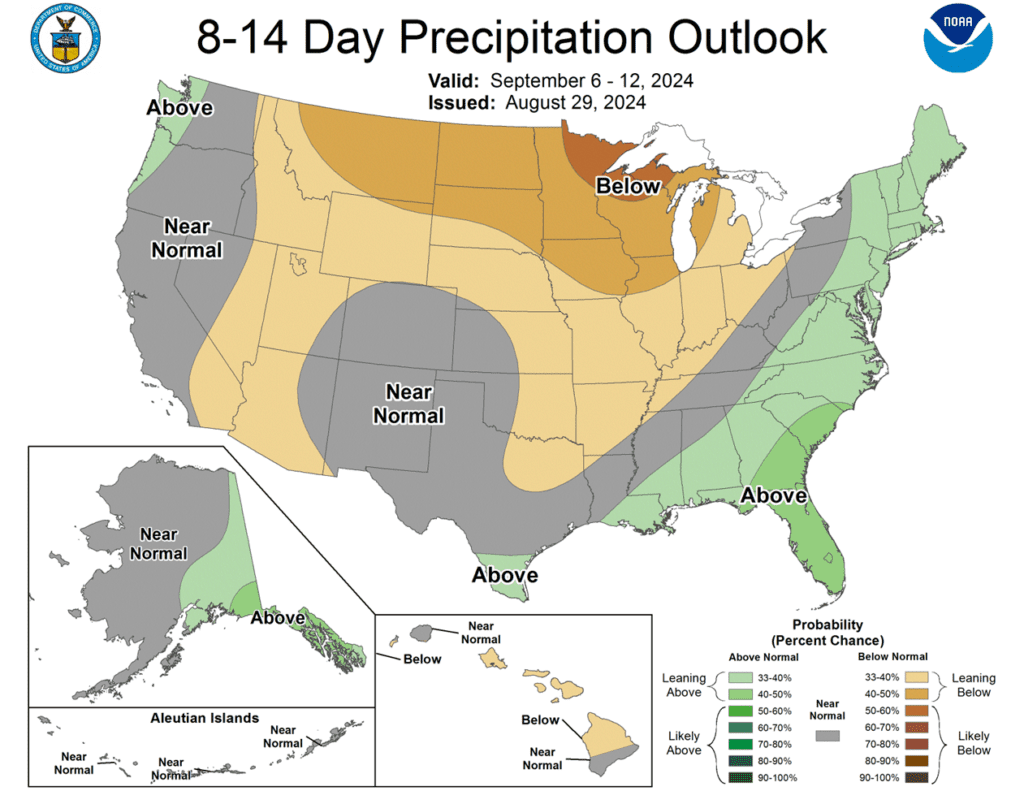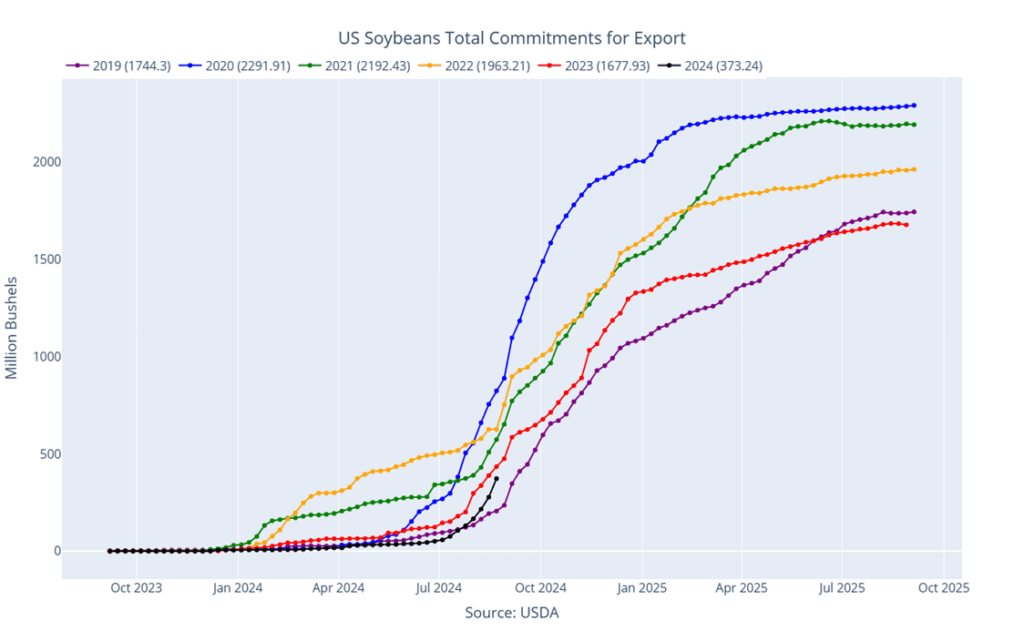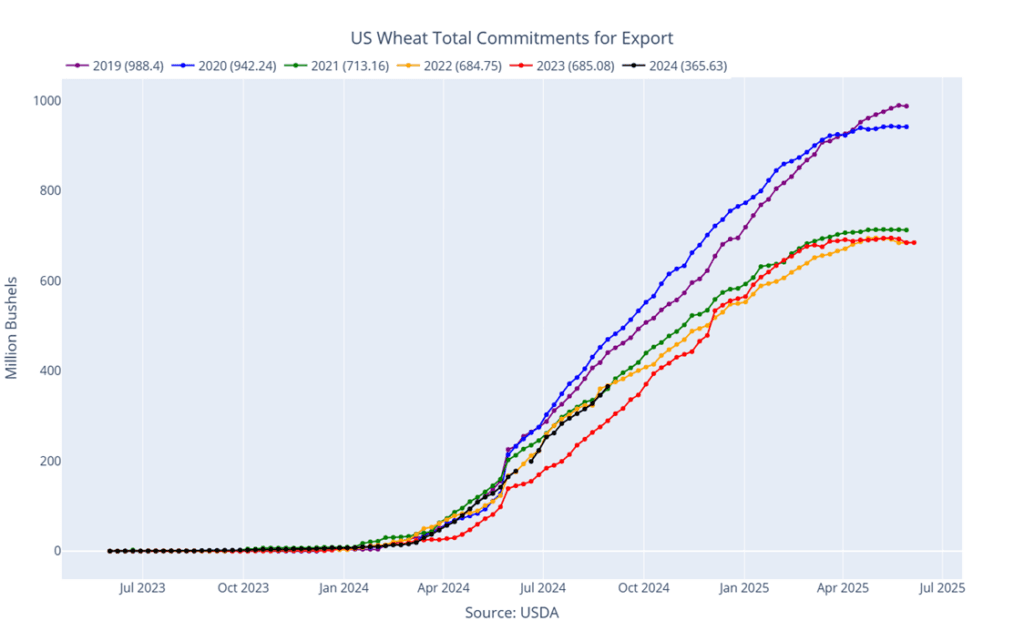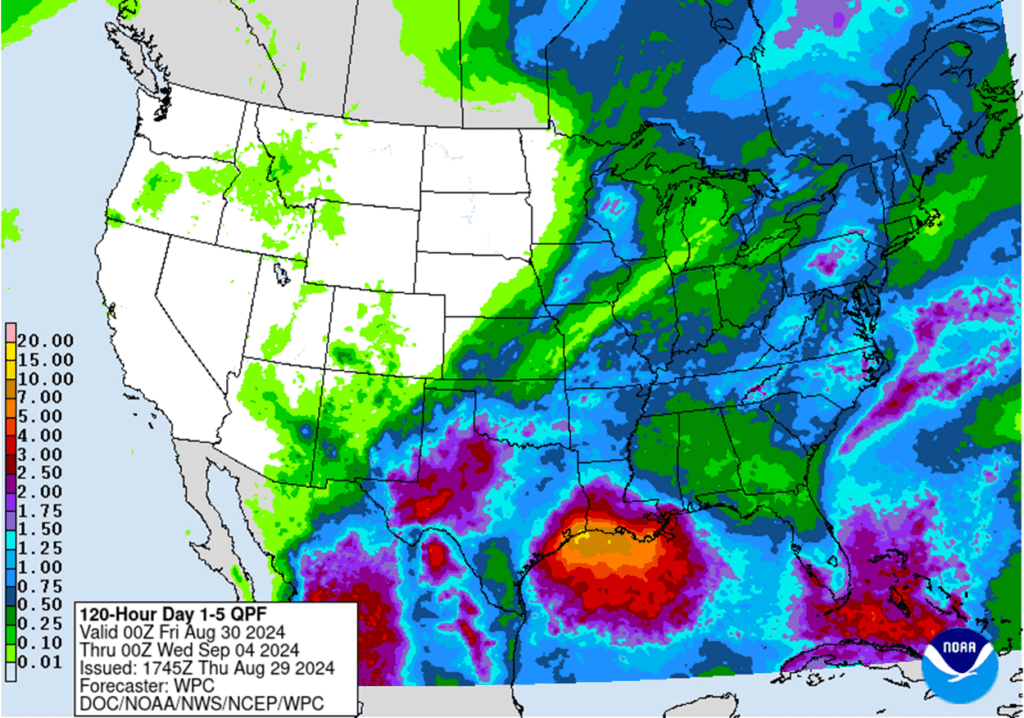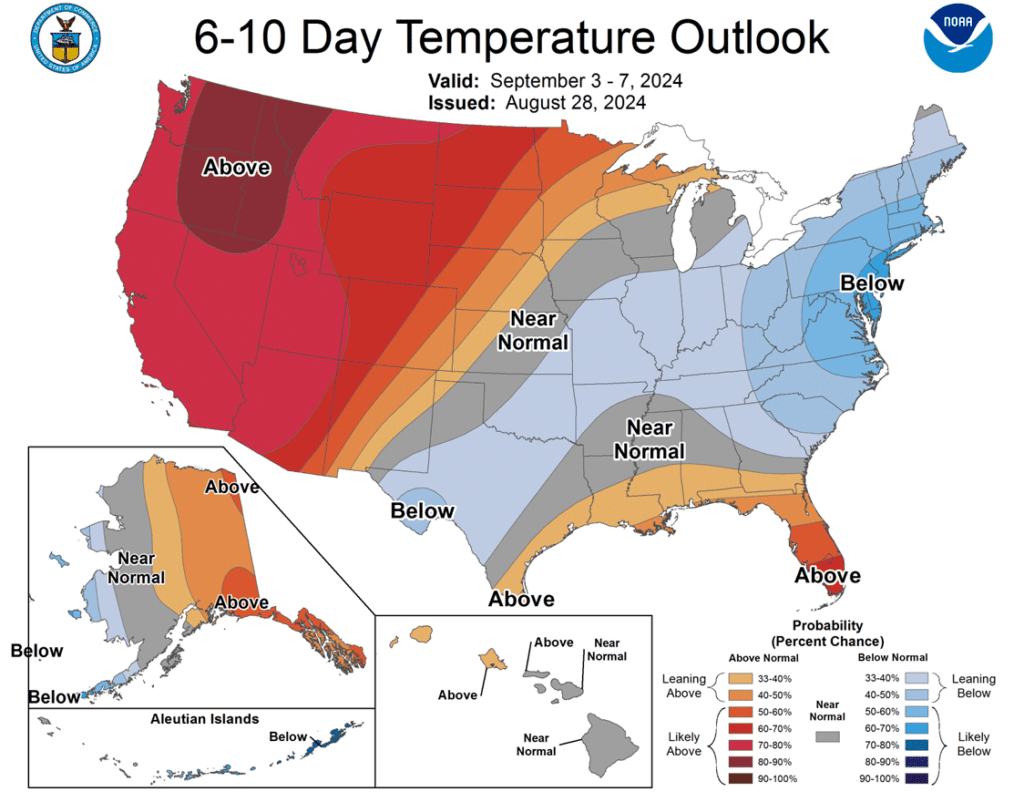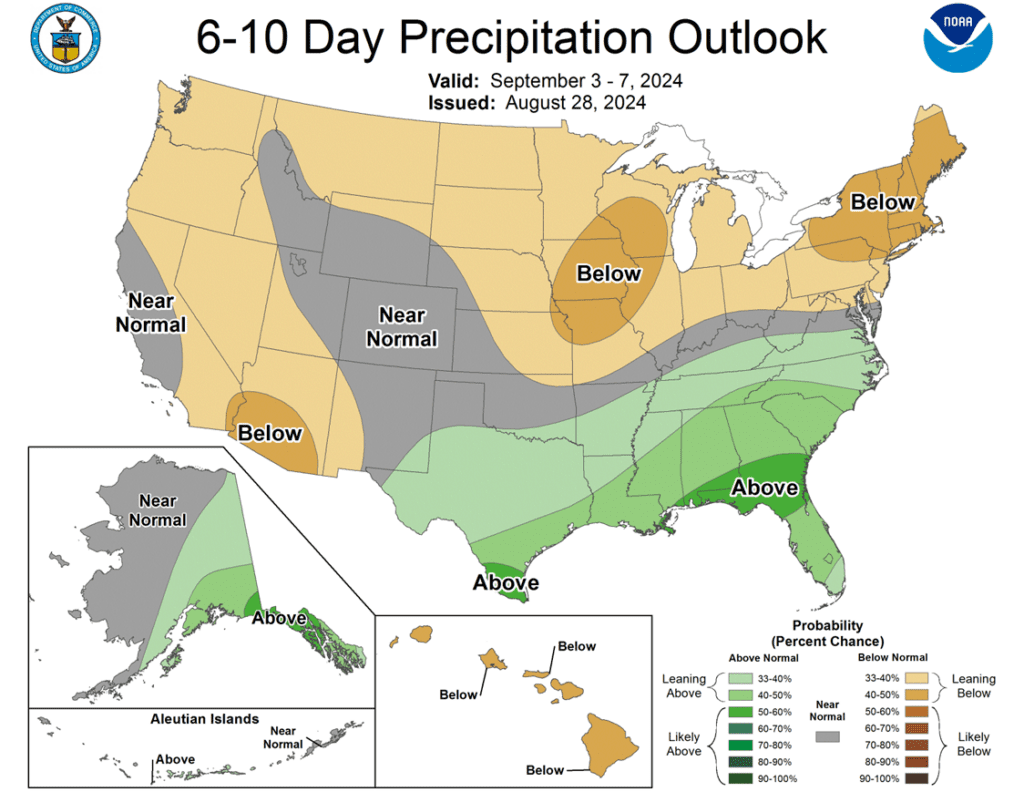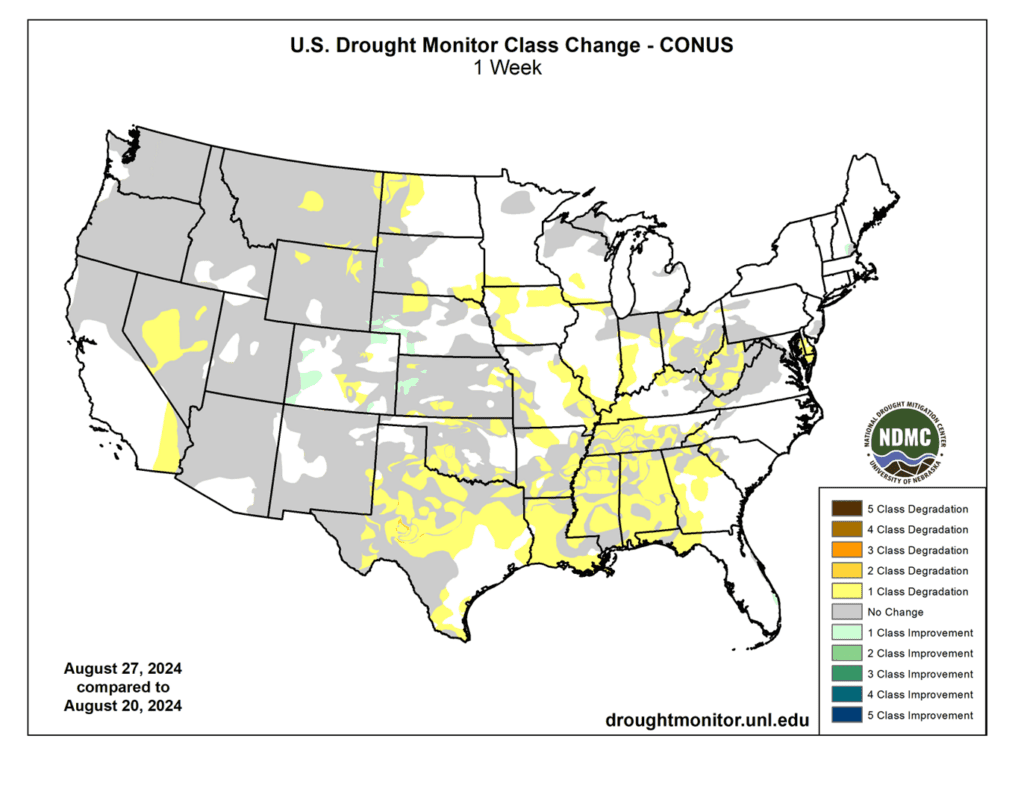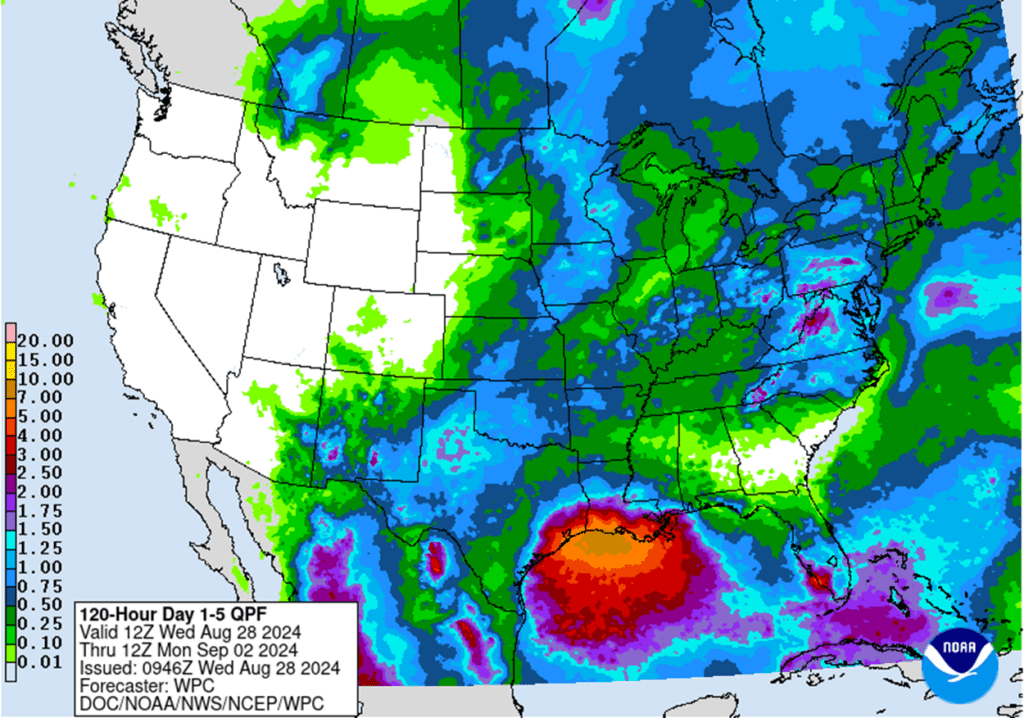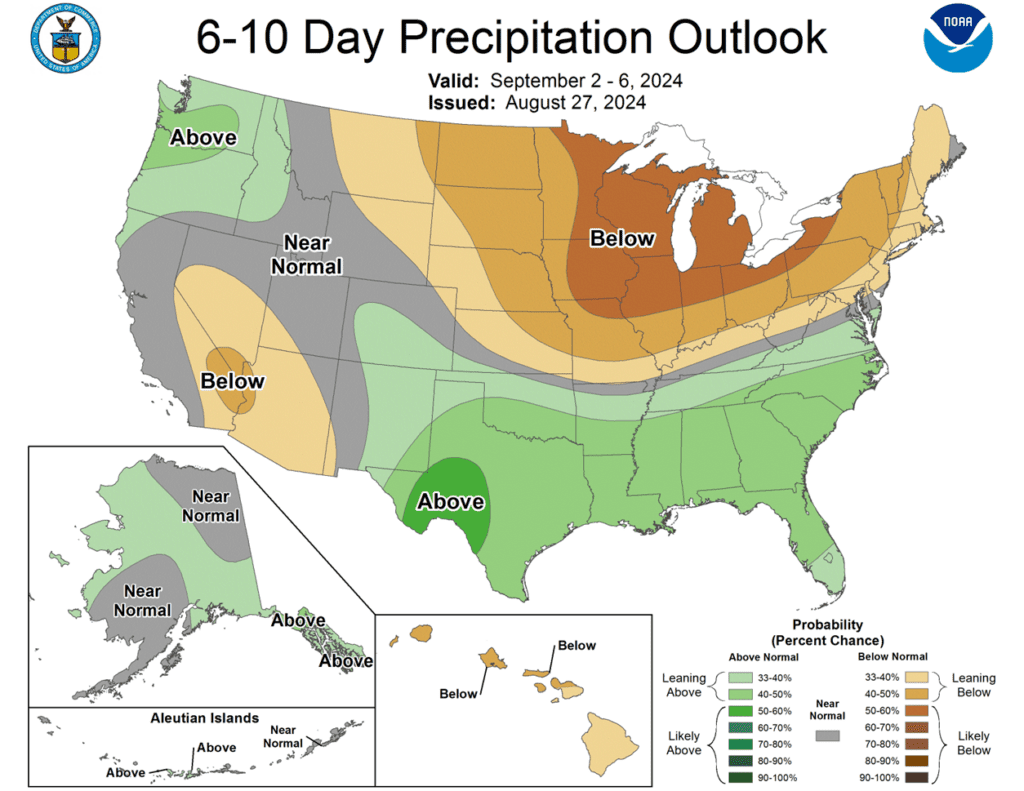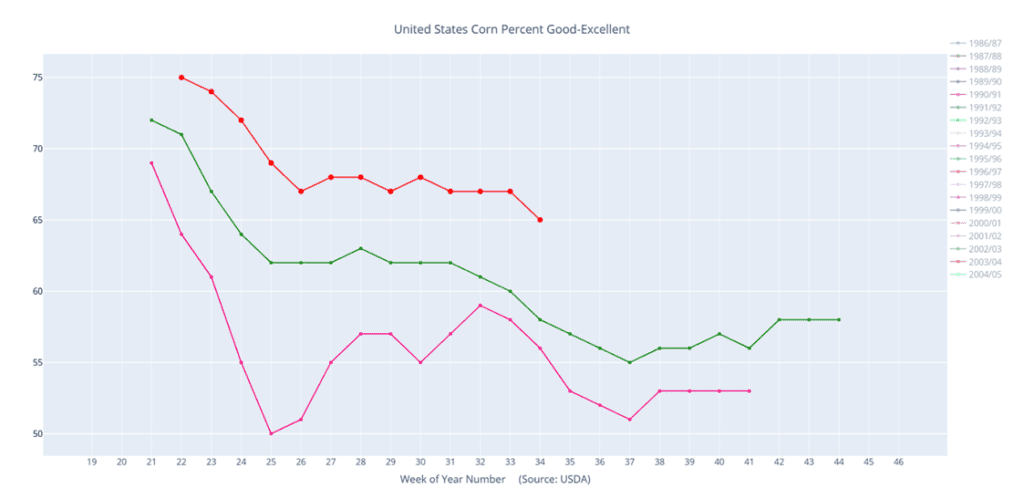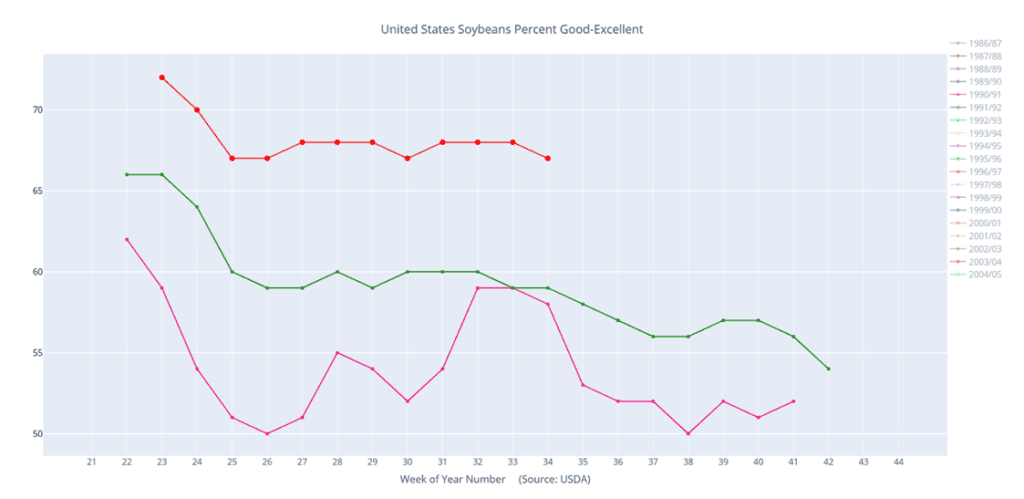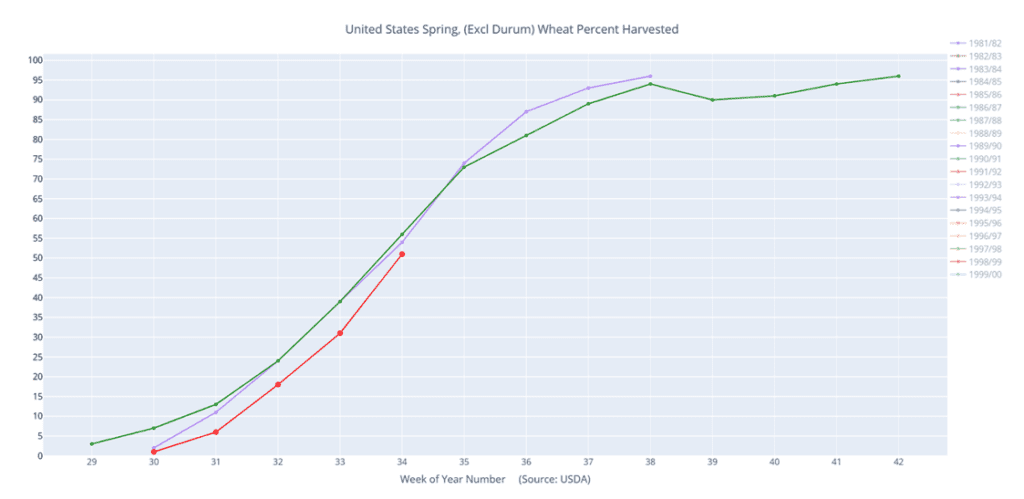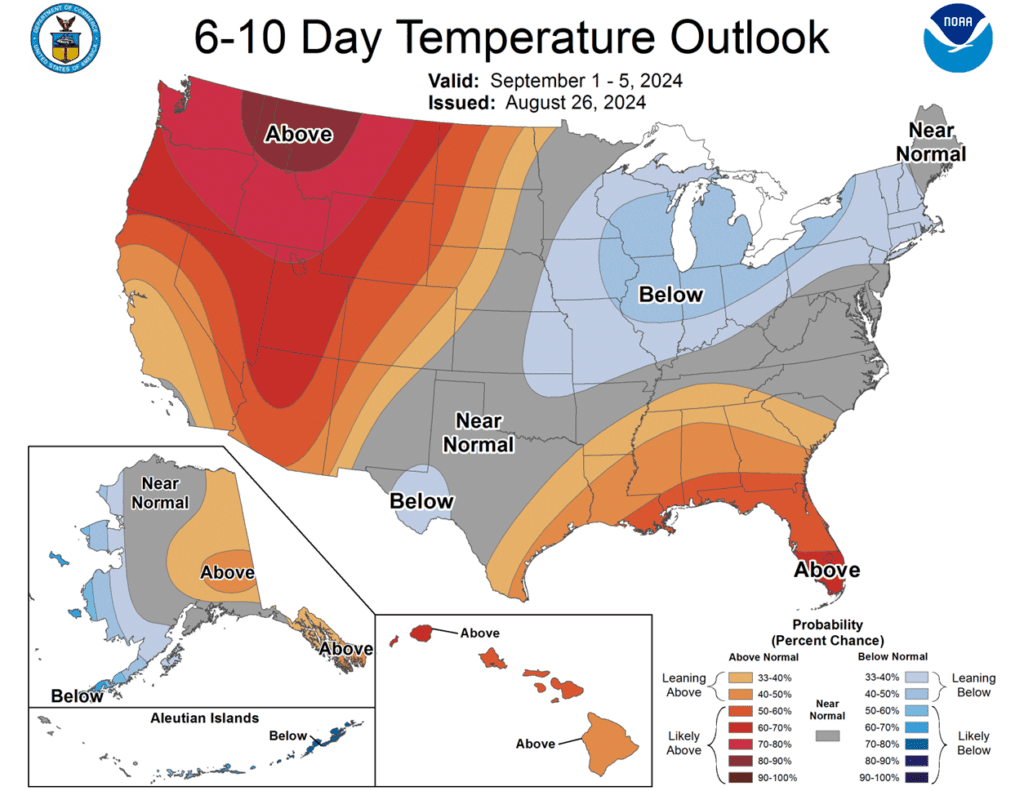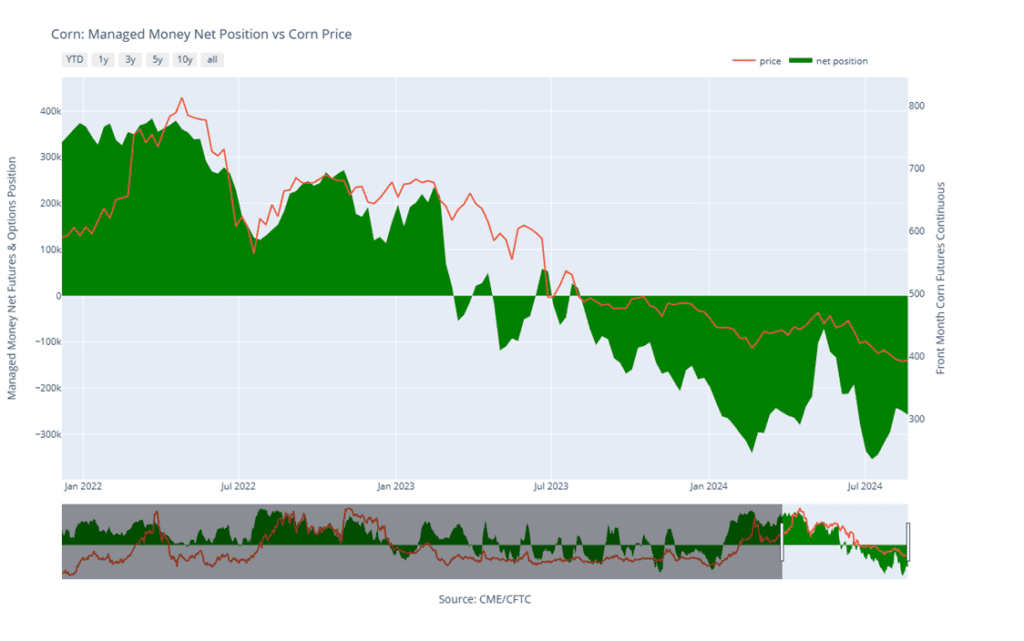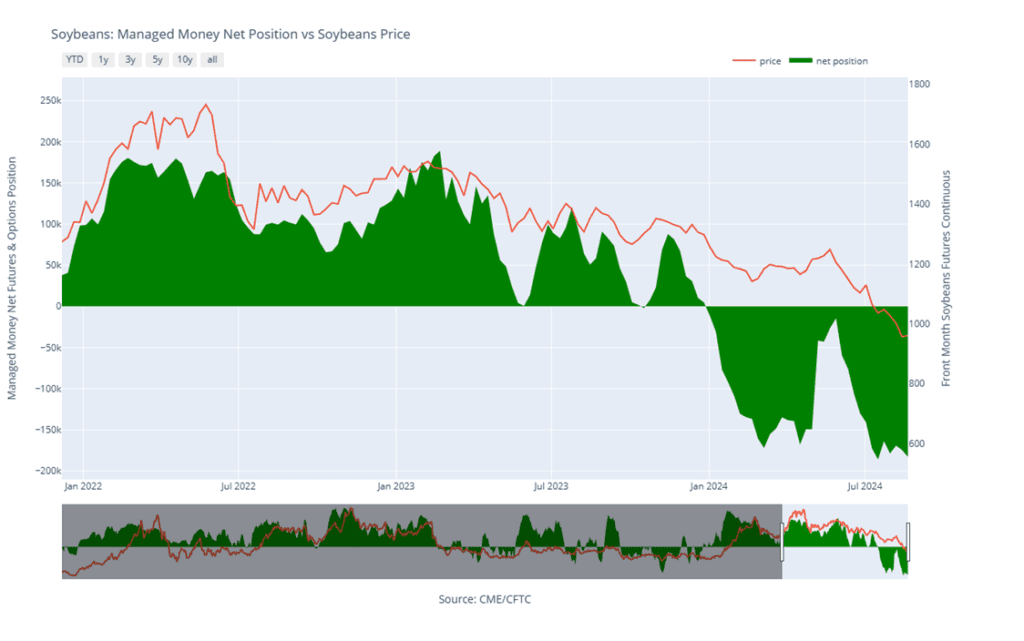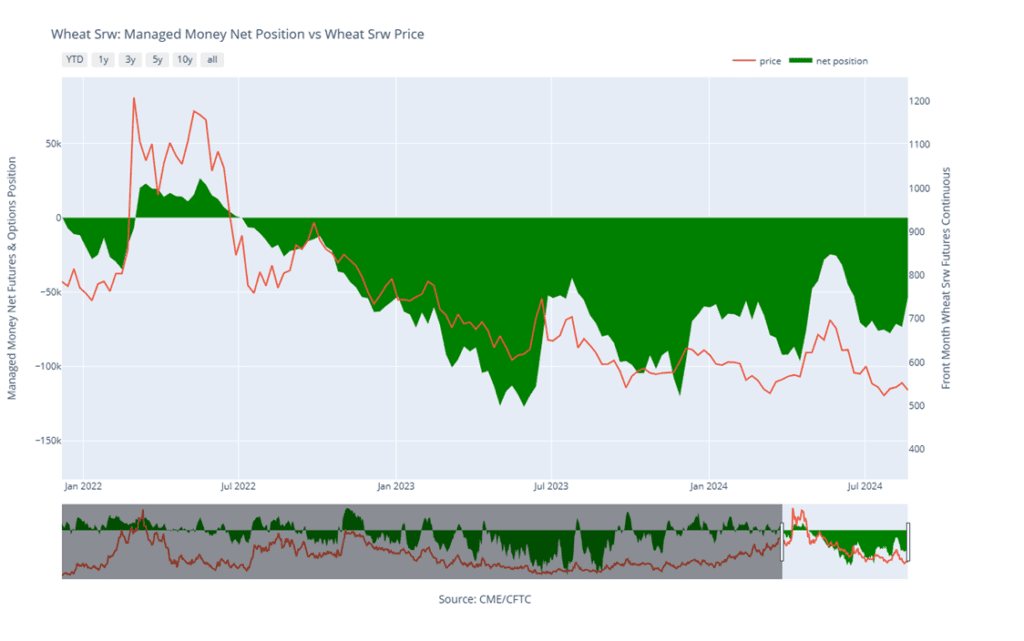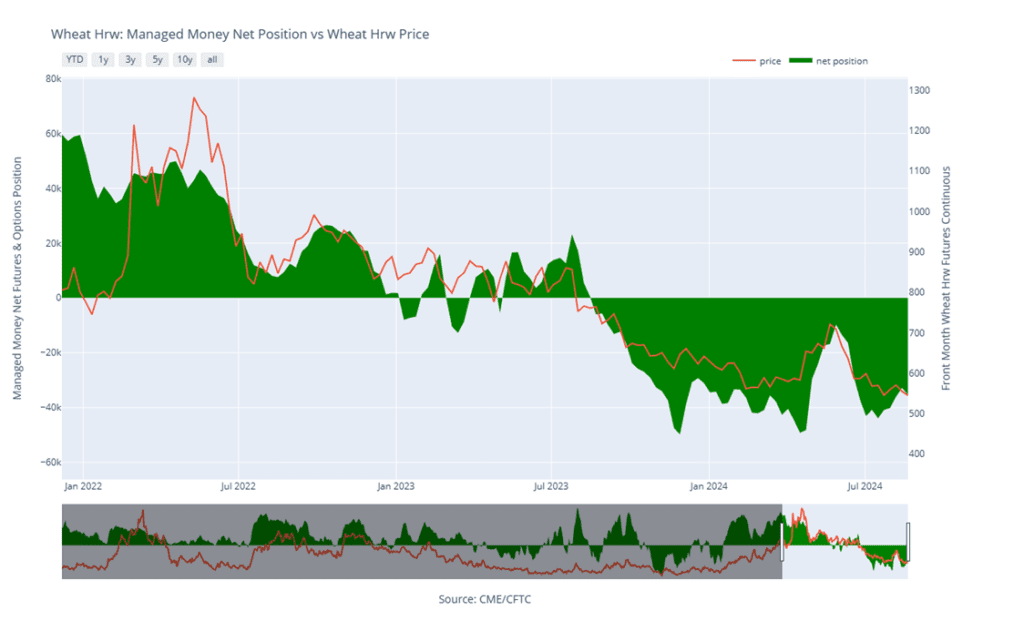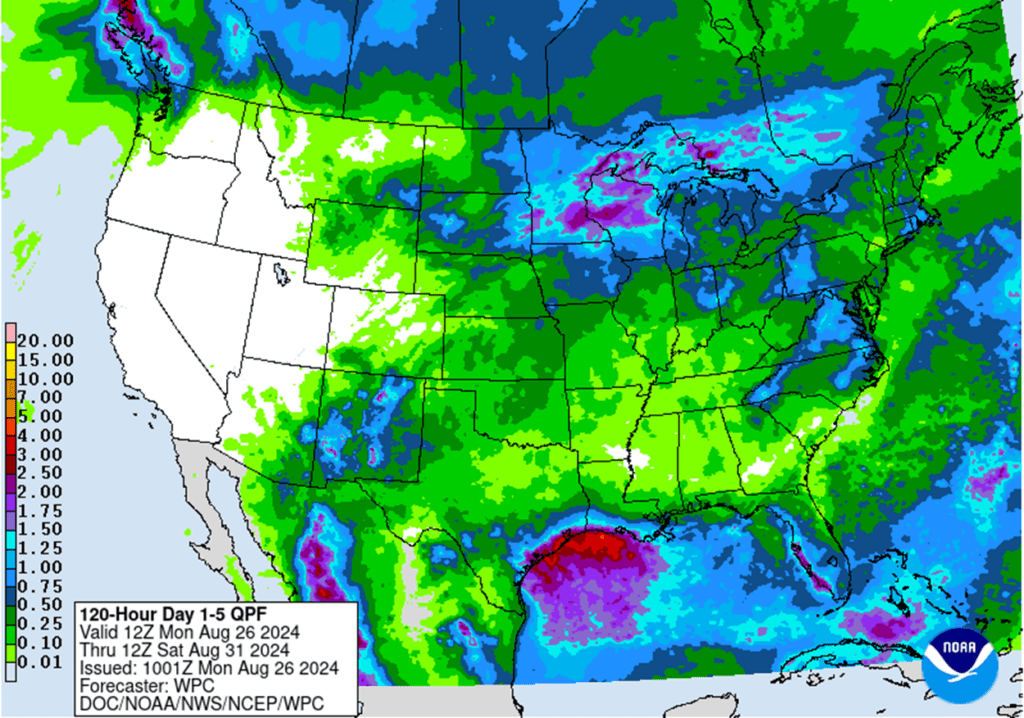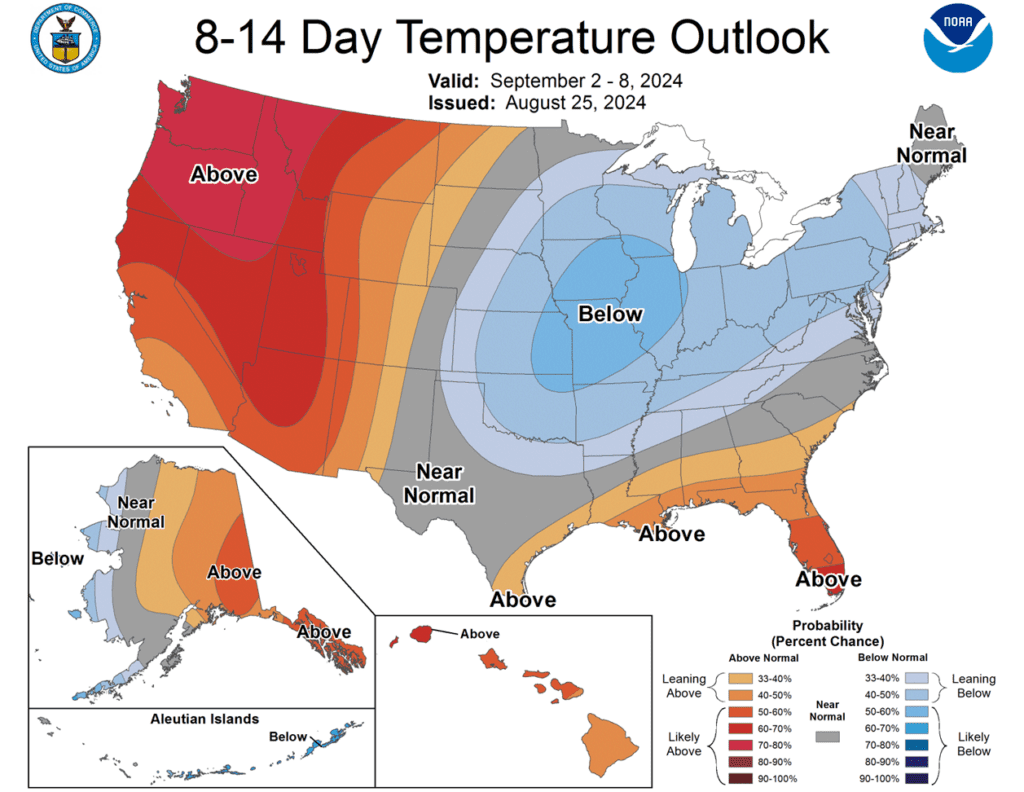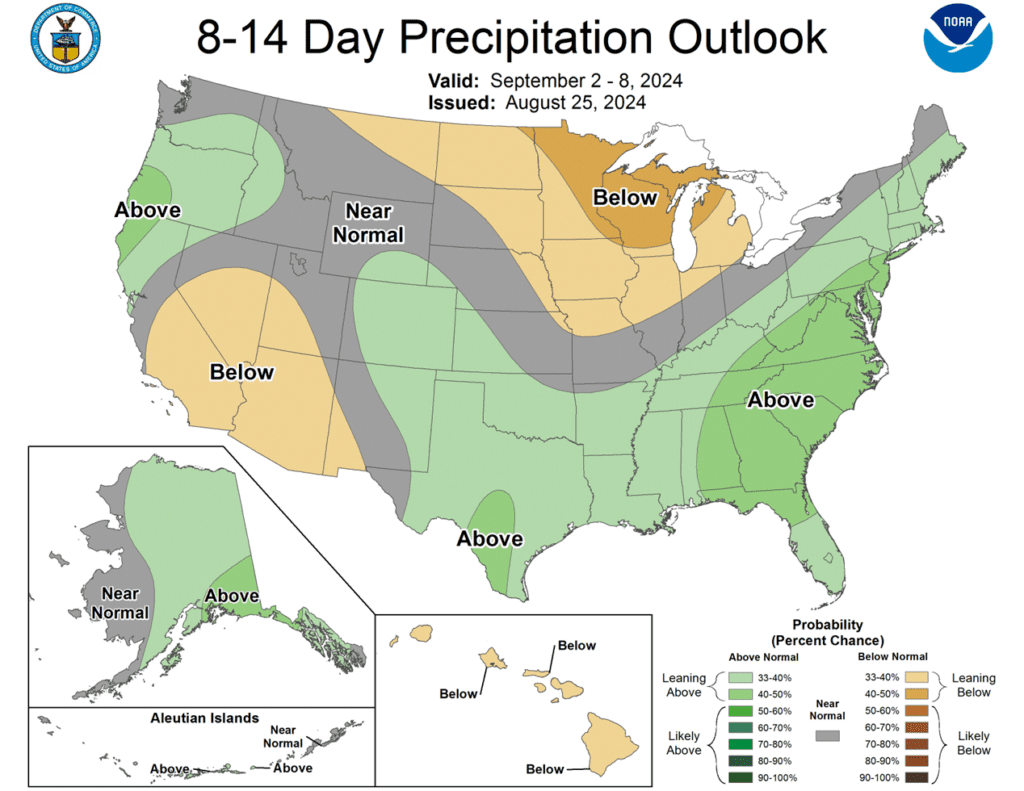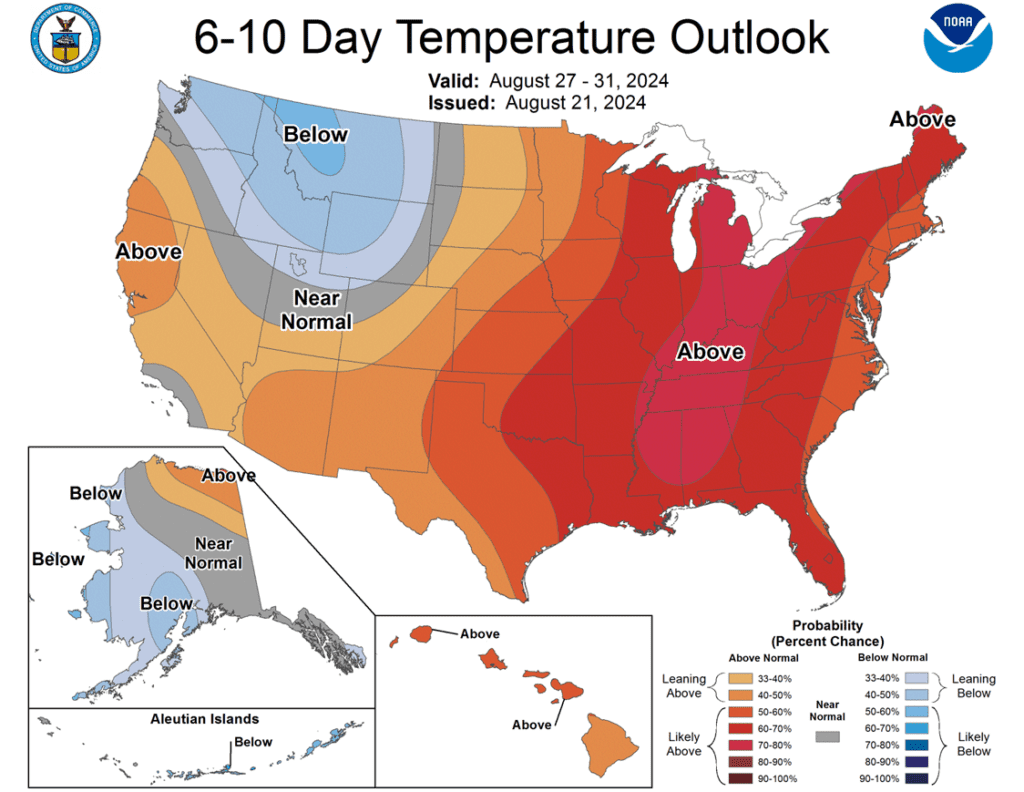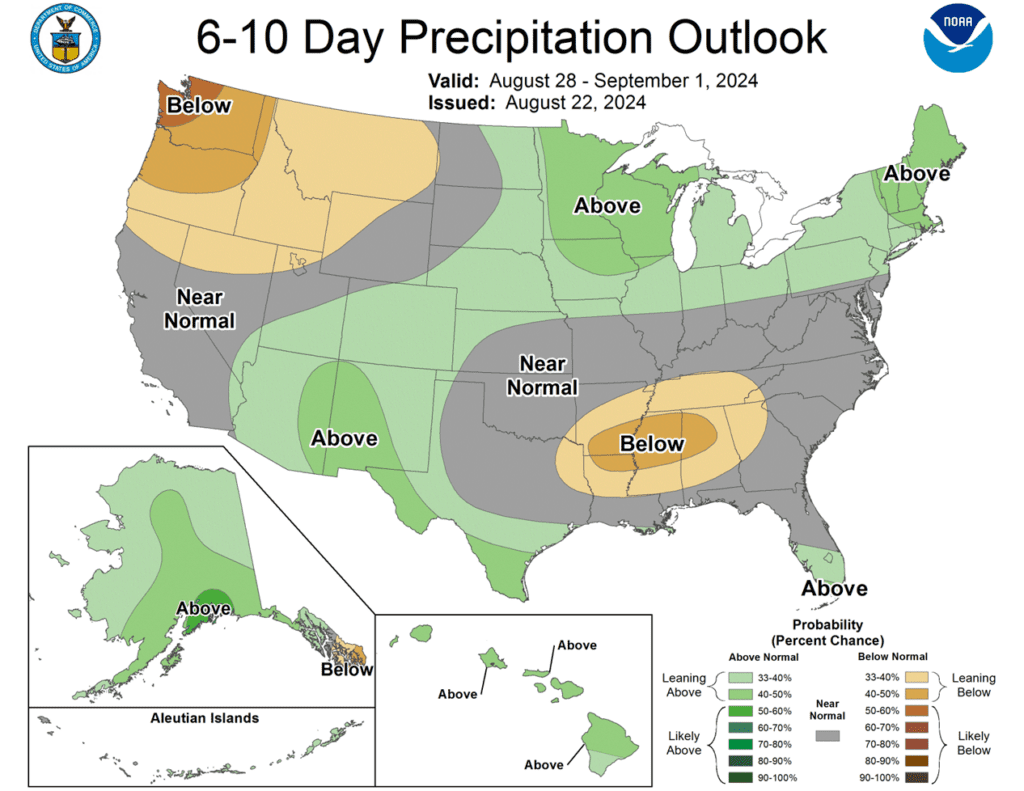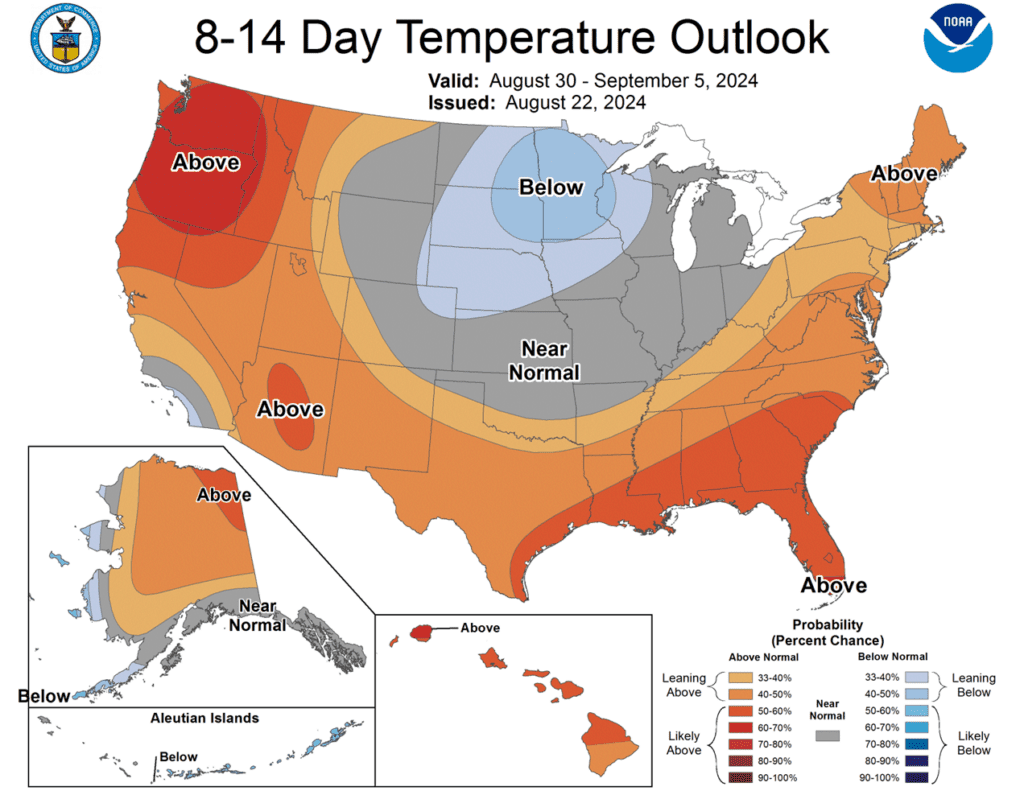9-6 End of Day: Grains Backtrack Friday After Strong Week
All prices as of 2:00 pm Central Time
Grain Market Highlights
- After starting Friday higher on higher-than-expected weekly new crop export sales, corn futures were dragged lower to end the session closing back near the 50-day moving average on December futures. While the short-term trend remains higher, Friday’s price action is unimpressive to corn bulls heading into the weekend.
- Soybean futures stumbled into the weekend after poor US economic data, giving back a majority of the gains accumulated during the past three trading sessions. Brazilian weather as well as US export news will continue to be most watched by the trade in the weeks to come with US harvest fast approaching.
- All three wheat classes moved in unison lower on Friday but still managed to close higher on the week. Today’s price action was not shocking given daily indictors were stretched to the upside heading into the end of the week.
- To see the updated Brazil 7-day precipitation anomaly forecast, and weeks 3-4 Temperature and Precipitation Outlooks, courtesy of NOAA, the Weather Prediction Center, scroll down to the other Charts/Weather section.
Note – For the best viewing experience, some Grain Market Insider content is best viewed with your phone held horizontally.
Corn
Corn Action Plan Summary
Since printing a market low in late August the corn market has rallied largely on fund short covering as the rush of old crop bushels into the market has slowed and demand has picked up. While the upcoming harvest of an expectedly large crop may continue to limit upside potential, it is a good sign that corn buyers are finding value at these multi-year low price levels. Any unexpected downward shift in anticipated supply or increase in demand could trigger managed funds to cover more of their extensive short positions and rally prices further, however, an extended rally is unlikely until after harvest.
- No new action is recommended for 2024 corn. In June we recommended buying Dec ’24 470 and 510 calls after Dec ’24 closed below 451, for their relative value and because we are at that time of year of high volatility when markets can move swiftly. Moving forward, our current strategy is to target the value of 29 cents to exit the Dec ’24 470 calls. Exiting the 470 calls at 29 cents will allow you to lock in gains in case prices fall back and hold the remaining 510 calls at or near a net neutral cost, which should continue to protect existing sales and give you confidence to make further sales if the market rallies sharply. Additionally, should a contra-seasonal rally occur considering the large net short managed fund position, we continue to target the 470 – 490 area to recommend making additional sales versus Dec ’24.
- No new action is currently recommended for 2025 corn. Between early June and late July Grain Market Insider made three separate sales recommendations to get early sales made for next year’s crop. Considering the seasonal weakness of the market in late summer and early fall, we will not be looking to post any targeted areas for new sales until late fall or early winter. Although, we will look to protect current sales, in the form of buying call options, should the market begin to show signs of a potential extended rally.
- No Action is currently recommended for 2026 corn. We currently aren’t considering any recommendations at this time for the 2026 crop that will be planted 2 years from now, and it may be some time before conditions are conducive to consider making any recommendations. Be patient as we monitor the markets for signs of improvement.
To date, Grain Market Insider has issued the following corn recommendations:

- Concerns regarding the general US economy after a disappointing jobs report, and downward revisions in previous job creations number triggered a risk off mindset across a majority of the markets. This negative tone spilled over into the corn market, putting a potential cap on the most recent rally.
- Dec corn futures finished 5 ¼ cents high on the week, but resistance at the $4.11 area held, and the weak price action on the day formed a bearish reversal on the daily charts. The key will likely be the price action next week.
- The USDA released the weekly export sales report this morning. For the last week of the marketing year, old crop corn saw net cancelations of 173,000 MT (6.8 mb) but new crop sales were strong at 1.843 MMT (71.7 mb). Some of the activity was rolling old crop sales into the new marketing year. The last two weeks on new crop corn sales have been above market expectations. Mexico continues to be the largest buyer of US corn.
- Logistics may become an issue in the corn market as harvest nears. Mississippi River levels in the Memphis area are at restrictive levels, reducing the volume of bushels that can be transported. The Army Corp of Engineers are dredging the area, but the additional freight costs will make US corn more expensive versus other global competitors.

Above: Since mid-August prices have largely been rangebound between 400 and 390. A close above the 400 – 414 resistance area could set prices up to rally toward the 430 area. Should they break and close below 385 support, they may be at risk of sliding towards the 372 support level.
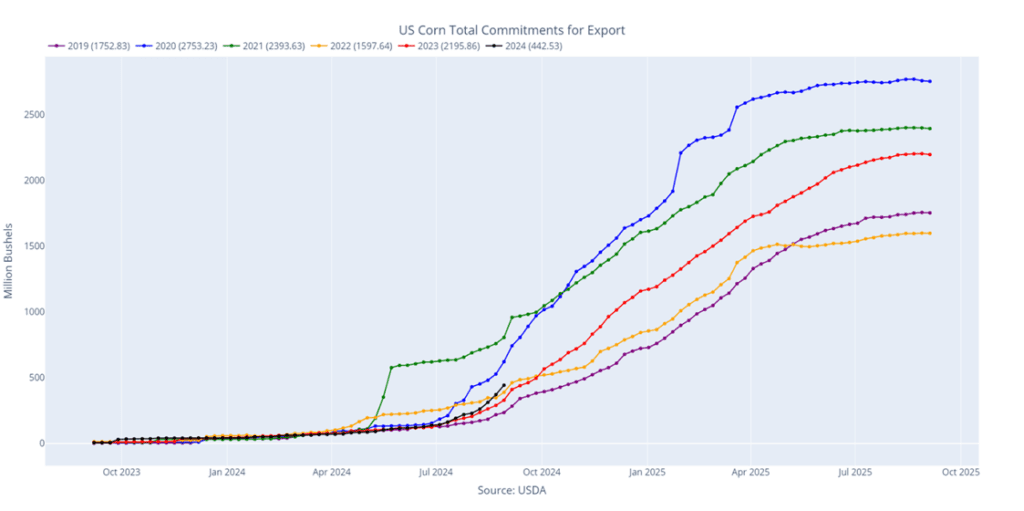
Soybeans
Soybeans Action Plan Summary
Since late May, the soybean market has steadily declined due to sluggish demand for the new crop, favorable growing conditions, and expectations of a large upcoming harvest. Weather forecasts have also generally remained supportive of the crop, while the market has factored in the likelihood of higher yields. With the weather turning drier as the crop enters its final development, the funds have covered some of their extensive short positions and rallied prices. While the market still anticipates a large crop at harvest, which could ultimately weigh on prices, should yields be less than expected, the recent pick up in demand could spur more short covering by the funds.
- No new action is recommended for the 2024 crop. At the end of December, we recommended buying Nov ’24 1280 and 1360 calls due to the amount of uncertainty in the 2024 soybean crop and to give you confidence to make sales and protect those sales in an extended rally. Given that the market has retreated since that time, we are targeting the 1040 – 1070 range versus Nov ’24 futures to exit 1/3 of the 1280 calls to help preserve equity. Additionally in June, the close below 1180 triggered our Plan B strategy, which recommended making additional sales due to the potential change in trend. Should a bullish catalyst enter the market to turn prices higher, we are targeting the 1090 – 1120 range from our Plan A strategy to make additional sales recommendations.
- No Action is currently recommended for 2025 Soybeans. To date, Grain Market Insider has not recommended any sales for next year’s soybean crop yet. First sales targets will probably be set in late fall or early winter at the earliest. Currently, our focus is on watching for opportunities to recommend buying call options. Should Nov ‘25 reach the upper 1100 range, the likelihood of an extended rally would increase, and we would recommend buying upside call options at that time in preparation for that possibility.
- No Action is currently recommended for 2026 Soybeans. We currently aren’t considering any recommendations at this time for the 2026 crop that will be planted 2 years from now, and it may be some time before conditions are conducive to consider making any recommendations. Be patient as we monitor the markets for signs of improvement.
To date, Grain Market Insider has issued the following soybean recommendations:

- Soybeans ended the day sharply lower going into the weekend after a revision in jobs data showing slower growth shook the whole market. November soybeans made a significant bearish reversal after moving up to but failing at the 50-day moving average. Soybean oil led the complex lower with a loss of 3.55% in the October contract and soybean meal was lower as well.
- For the week, November soybeans gained 5 cents at $10.05 and March 25 soybeans gained 4-3/4 to $10.36-1/2. December soybean meal gained $11.40 to $324.40 and December soybean oil lost 2.38 cents to 39.63 cents. Funds had previously been exiting short positions earlier this week but clearly added to that position in a big way today.
- Today’s export sales report was strong for soybeans and provided support this morning before other macro events brought markets lower. There were net cancellations of 8.4 mb of soybeans for 23/24 but an increase of 60.9 mb for 24/25 which was above trade expectations. Last week’s export shipments of 18.0 mb were below the 21.4 mb needed each week to meet the USDA’s expectations. Primary destinations were to China, Mexico, and Indonesia.
- In Argentina, soy crush workers had previously been striking due to low wages, but an agreement was reached between the union and agricultural traders which has ended the strike. They achieved a 26% raise.

Above: The recent rally has brought November soybeans into the 1005 – 1040 resistance area. A close above this range could set the market up for a rally toward the July high of 1082 ¼. To the downside, a break below 950 puts the market at risk of sliding down to the 915 – 900 support area.
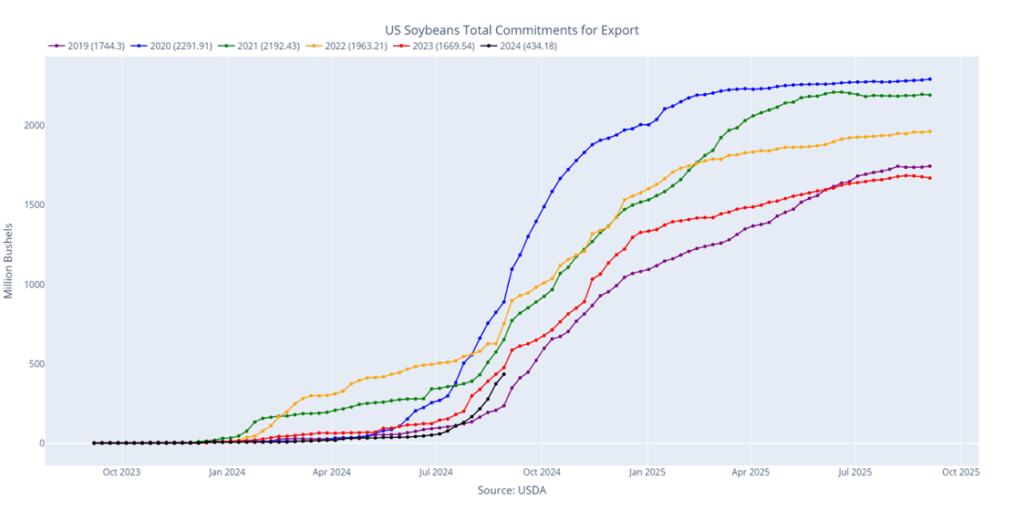
Wheat
Market Notes: Wheat
- Wheat posted losses alongside the rest of the grain complex, most other commodities, and the stock market. It appears to have been a risk off session caused by a combination of a technical correction from overbought territory, profit taking at key resistance levels, and a jobs report this morning that indicated the economy added fewer jobs than expected; there were also downward revisions for the previous two months.
- The USDA reported an increase of 12.5 mb of wheat export sales for 24/25, and net cancellations of 0.4 mb for 25/26. Shipments last week at 23.4 mb exceeded the 15.9 mb pace needed per week to reach the USDA’s export goal of 825 mb. Sales commitments for 24/25 have reached 378 mb which is up 31% from last year and above the USDA’s estimated pace of 17% higher.
- Argentina’s wheat production estimate was left unchanged by the Buenos Aires Grain Exchange at 18.5 mmt. This is despite drought conditions affecting some key growing regions. For reference, the USDA estimate is 18.0 mmt. There were some storms over the past weekend that may have helped stabilize the crop, but dry weather is likely to follow for at least the next week.
- Russia has reportedly reduced their wheat export tax by 19% to 906.4 rubles per mt (for the period ending September 17). Additionally, Russian export prices for wheat remain cheap; the week was ended at $217 per mt which is unchanged from the past few weeks.
- The global wheat production estimate was increased to 791.4 mmt, according to the UN Food and Agriculture Organization. This compares with the July estimate at 789.1 mmt. Better than anticipated crops in the US and upward revisions in China and Argentina are cited as the reason for the increase. However, there were downward revisions for both Russia and the EU.
Chicago Wheat Action Plan Summary
Since mid-July, the wheat market has mostly drifted sideways as the trade tries to balance smaller US and global supplies against cheaper world export prices. During this period, a potential seasonal low was also marked on July 29th as managed funds maintained a sizable net short position in Chicago wheat. While slow global import demand and low Russian export prices continue to be a limiting factor in the market, any increase in US demand due to smaller crops in Europe and the Black Sea region could trigger an extended short-covering rally by managed funds.
- No new action is recommended for 2024 Chicago wheat. Considering the recent rally in wheat, we recommended taking advantage of the elevated prices to make additional sales and buy upside July ’25 860 and 1020 calls (for their extended time frame) in case of a protracted rally. Our current strategy is to target 740 – 760 versus Sept ’24 to recommend further sales and to target a selling price of about 73 cents in the 860 calls to achieve a net neutral cost on the remaining 1020 calls. The remaining 1020 calls would then continue to protect existing sales and give you confidence to make additional sales at higher prices.
- Grain Market Insider sees a continued opportunity to sell another portion of your 2025 SRW wheat crop. Since posting the recent low, July ’25 Chicago wheat prices have rallied about 50 cents and have entered the congestion and resistance area from early July. Considering there may be significant resistance overhead in this area, we recommend taking advantage of this rally to make an additional sale on a portion of your anticipated 2025 soft red winter wheat crop, using either July ’25 Chicago wheat futures, or a July ’25 HTA contract, so basis can be set at a more advantageous time later on.
- No action is currently recommended for 2026 Chicago Wheat. We currently aren’t considering any recommendations at this time for the 2026 crop that will be planted next year, and it may be some time before conditions are conducive to consider making any recommendations. Be patient as we monitor the markets for signs of improvement.
To date, Grain Market Insider has issued the following Chicago wheat recommendations:


Above: The market’s close above the 50-day moving average set it up for a potential challenge of the 560 – 570 resistance area, and a rally towards 590 – 595. Should prices reverse and close back below the 50-day moving average, they could again find support near 514, with further support around 500 and 488.
KC Wheat Action Plan Summary
Since mid-July, the wheat market has mostly drifted sideways as the trade tries to balance smaller US and global wheat supplies against cheaper world export prices. During this period, a potential seasonal low was also marked on the front month continuous charts as managed funds maintained a sizable net short position in the wheat markets. While low Black Sea export prices and slow world demand continue to weigh on US prices, the funds’ short position could trigger an extended short covering rally on any increase in US demand as world wheat ending stocks are expected to fall yet again this year.
- No new action is recommended for 2024 KC wheat. Considering the recent upside breakout in KC wheat, we recommended buying upside July ’25 860 and 1020 calls (for their extended time frame) in case of a protracted rally. Our current strategy is to target 725 – 750 versus Sept ’24 to recommend further sales and to target a selling price of about 71 cents on the 860 calls to achieve a net neutral cost on the remaining 1020 calls. The remaining 1020 calls would then continue to protect existing sales and give you confidence to make additional sales at higher prices.
- No new action is currently recommended for 2025 KC Wheat. We recently recommended exiting half of the previously recommended July ’25 620 puts once they reached 60 cents (double the original approximate cost) to realize gains in case the market rallies back, while still holding the remaining 620 puts at, or near, a net neutral cost for continued downside coverage on any unsold bushels. Looking ahead, our strategy is to target the 640 – 670 range to recommend making additional sales.
- No action is currently recommended for 2026 KC Wheat. We currently aren’t considering any recommendations at this time for the 2026 crop that will be planted next year, and it may be some time before conditions are conducive to consider making any recommendations. Be patient as we monitor the markets for signs of improvement.
To date, Grain Market Insider has issued the following KC recommendations:


Above: December wheat appears poised to test overhead resistance near 600, with additional moving average resistance just above there between 605 – 610. If the market turns lower, initial support remains near the 50-day moving average, with further support near the recent 527 ¼ low.
Mpls Wheat Action Plan Summary
Since printing a near-term low in mid-July, Minneapolis wheat has trended mostly sideways as the market attempts to balance smaller US and world supplies versus lower world export prices and lower world demand. During this period, managed funds have maintained their sizable, short positions in Minneapolis wheat. Though low Russian export prices continue to keep a lid on US prices, smaller crops in Europe and the Black Sea region could increase US demand, potentially triggering an extended short-covering rally, especially as global wheat ending stocks are projected to decline again this year.
- No new action is recommended for 2024 Minneapolis wheat. With the recent close below the 712 support level, Grain Market Insider implemented its Plan B stop strategy, recommending additional sales for the 2024 crop due to waning upside momentum and an increased likelihood of a downward trend. Given the heightened volatility and the amount of time that remains to market this crop, we will maintain the current July ’25 KC wheat 860 and 1020 call options. Our target is a selling price of about 71 cents for the 860 calls to achieve a net neutral cost on the remaining 1020 calls. These 1020 calls will continue to protect existing sales and provide confidence to make additional sales at higher prices.
- No new action is currently recommended for the 2025 Minneapolis wheat crop. Since the growing season can often yield some of the best sales opportunities, we recently made two separate sales recommendations to get some early sales on the books for next year’s crop. While we will not be targeting any specific areas to make additional sales until later in the marketing year, we will continue to monitor the market for opportunities to exit the remaining July ’25 KC 620 puts that were recommended in June. To that end, should the market continue to be weak, we are currently targeting the upper 400 range to exit half of those remaining puts.
- No Action is currently recommended for the 2026 Minneapolis wheat crop. We currently aren’t considering any recommendations at this time for the 2026 crop that will be planted 2 years from now, and it may be some time before conditions are conducive to consider making any recommendations. Be patient as we monitor the markets for signs of improvement.
To date, Grain Market Insider has issued the following Minneapolis wheat recommendations:


Above: December Minneapolis wheat appears to have found support near 560. Should prices continue higher, they could encounter resistance in the 617 – 637 area. To the downside, a break below 560 could put the market at risk of a further decline towards support around 540.
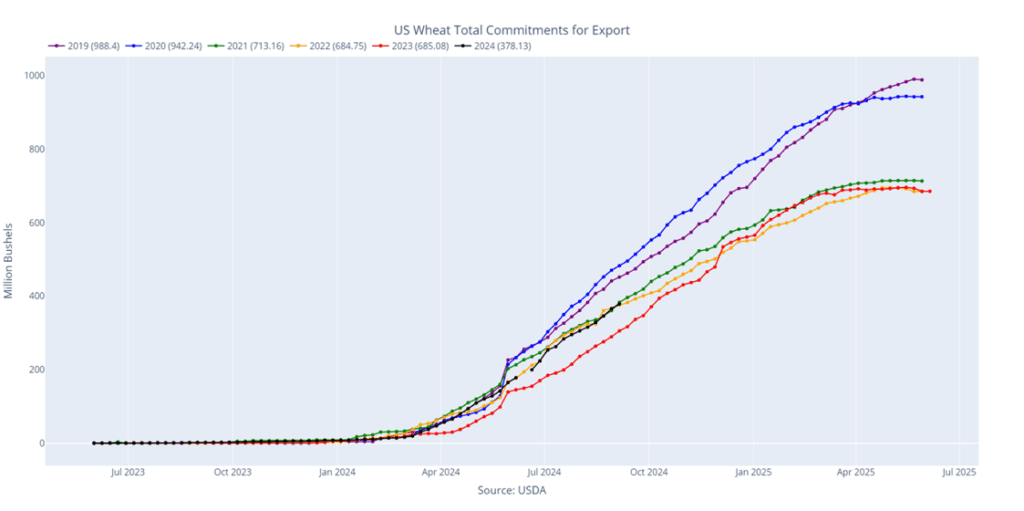
Other Charts / Weather









